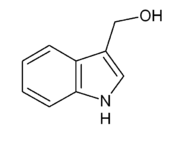This article needs additional citations for verification. (February 2012) |

| |
| Names | |
|---|---|
| Preferred IUPAC name
(1H-Indol-3-yl)methanol | |
| Other names
Indole-3-carbinol; 3-Indolylcarbinol; 1H-Indole-3-methanol; 3-Hydroxymethylindole; 3-Indolemethanol; Indole-3-methanol; I3C
| |
| Identifiers | |
3D model (JSmol)
|
|
| ChEBI | |
| ChEMBL | |
| ChemSpider | |
| ECHA InfoCard | 100.010.762 |
| EC Number |
|
PubChem CID
|
|
| RTECS number |
|
| UNII | |
CompTox Dashboard (EPA)
|
|
| |
| |
| Properties | |
| C9H9NO | |
| Molar mass | 147.177 g·mol−1 |
| Appearance | Off-white solid |
| Melting point | 96 to 99 °C (205 to 210 °F; 369 to 372 K) |
| Partially in cold water[vague] | |
| Hazards | |
| GHS labelling:[2] | |

| |
| Warning | |
| H315, H319 | |
| P305+P351+P338 | |
| NFPA 704 (fire diamond) | |
Except where otherwise noted, data are given for materials in their standard state (at 25 °C [77 °F], 100 kPa).
| |
Indole-3-carbinol (I3C, C9H9NO) is produced by the breakdown of the glucosinolate glucobrassicin, which can be found at relatively high levels in cruciferous vegetables such as broccoli, cabbage, cauliflower, brussels sprouts, collard greens and kale. It is also available in dietary supplements.[3] Indole-3-carbinol is the subject of on-going biomedical research into its possible anticarcinogenic,[4] antioxidant, and anti-atherogenic effects.[5] Research on indole-3-carbinol has been conducted primarily using laboratory animals and cultured cells.[6] Limited and inconclusive human studies have been reported. A recent review of the biomedical research literature found that "evidence of an inverse association between cruciferous vegetable intake and breast or prostate cancer in humans is limited and inconsistent" and "larger randomized controlled trials are needed" to determine if supplemental indole-3-carbinol has health benefits.[7]
- ^ Data at chemblink.com
- ^ GHS: Sigma-Aldrich i7256
- ^ Sarubin-Fragakis, A.; Thomson, C.; American Dietetic Association (2007). The Health Professional's Guide to Popular Dietary Supplements. American Dietetic Association. p. 312. ISBN 9780880913638.
- ^ Park, N. I.; Kim, J. K.; Park, W. T.; Cho, J. W.; Lim, Y. P.; Park, S. U. (2010). "An efficient protocol for genetic transformation of watercress (Nasturtium officinale) using Agrobacterium rhizogenes". Molecular Biology Reports. 38 (8): 4947–4953. doi:10.1007/s11033-010-0638-5. PMID 21161399. S2CID 19612120.
- ^ "indole-3-methanol (CHEBI:24814)". Chemical Entities of Biological Interest (ChEBI). European Bioinformatics Institute. Retrieved 2016-03-25.
- ^ Tilton, S. C.; Hendricks, J. D.; Orner, G. A.; Pereira, C. B.; Bailey, G. S.; Williams, D. E. (2007). "Gene expression analysis during tumor enhancement by the dietary phytochemical, 3,3′-diindolylmethane, in rainbow trout". Carcinogenesis. 28 (7): 1589–1598. doi:10.1093/carcin/bgm017. PMID 17272308.
- ^ Higdon, J.; Delage, B.; Williams, D.; Dashwood, R. (2007). "Cruciferous vegetables and human cancer risk: Epidemiologic evidence and mechanistic basis". Pharmacological Research. 55 (3): 224–236. doi:10.1016/j.phrs.2007.01.009. PMC 2737735. PMID 17317210.
